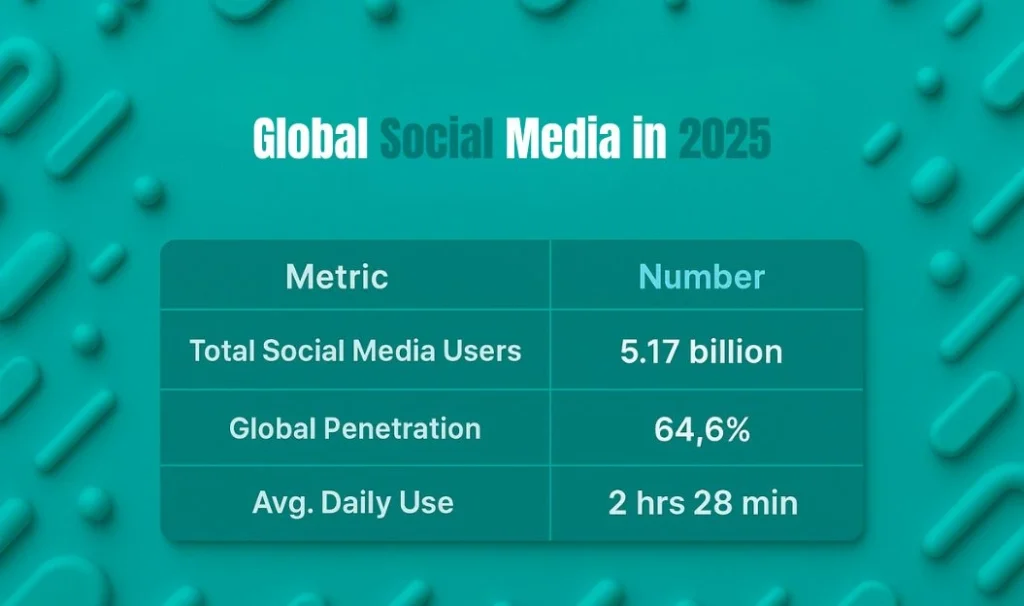Over 5 billion people are using social media in 2025, but which platforms truly stand out? Here are the top 40 platforms shaping how we connect and communicate today.
Social media isn’t just about connecting anymore. In 2025, it’s influencing culture, commerce, and communication on a massive scale. With over 5.17 billion users worldwide, the space is growing faster than ever.
In this article, we’ve compiled a detailed, up-to-date list of the top 40 platforms—from the giants you already know to the new names making noise in niche communities.
Global Social Media in 2025
Key Stats
| Metric | Number |
|---|---|
| Total Social Media Users | 5.17 billion |
| Global Penetration | 64.6% |
| Avg. Daily Use | 2 hrs 28 min |

What’s New in 2025
- Short videos remain a favorite across platforms
- AI content feeds are making experiences more personal
- Communities are getting smaller but more loyal — think niche networks, not just viral moments
Top 10 Platforms by Monthly Active Users
These are the current leaders by global usage:
| Rank | Platform | MAUs (in billions) |
| 1 | 3.07 | |
| 2 | YouTube | 2.53 |
| 3 | 2.00 | |
| 4 | 2.00 | |
| 5 | TikTok | 1.59 |
| 6 | 1.38 | |
| 7 | Telegram | 0.95 |
| 8 | Messenger | 0.947 |
| 9 | Snapchat | 0.85 |
| 10 | Douyin | 0.766 |
Each platform’s success is driven by features like:
- Facebook: Strong groups, business tools, and wide demographic
- YouTube: Long and short-form video, monetization programs
- Telegram: Secure, channel-based messaging
- TikTok & Douyin: Creators + viral loops = massive reach
Platforms Ranked 11–20
| Rank | Platform | MAUs (in millions) |
| 11 | Kuaishou | 714 |
| 12 | 606 | |
| 13 | 599 | |
| 14 | X (Twitter) | 586 |
| 15 | 562 | |
| 16 | 537 | |
| 17 | 500 | |
| 18 | Threads | 275 |
| 19 | Discord | 250 |
| 20 | Twitch | 200 |
Some standouts:
- Reddit is booming thanks to community-led content
- Pinterest thrives with lifestyle inspiration and e-commerce
- Threads is Meta’s bet on micro-conversations
- Twitch continues to lead in live-streamed gaming
Emerging and Niche Platforms (21–40)
These are smaller but fast-growing or unique enough to matter:
21. Lemon8 – Lifestyle-focused visuals with ecommerce twist
22. BeReal – Promotes unfiltered, daily moments
23. Mastodon – Federated social posting
24. Bluesky – Twitter alternative with decentralized tech
25. Substack Notes – For writers and thought leaders
26. Noplace – Retro social for Gen Z
27. Ten Ten – Private group-sharing app
28. Airchat – Voice-first social experience
29. Yik Yak – Anonymous hyperlocal updates
30. Coverstar – Teen-focused video talent platform
31. Vero – Ad-free, chronological sharing
32. Minds – Privacy-focused, open source
33. Spill – Culture-led shortform network
34. Spoutible – Safe-space social for news discussion
35. CounterSocial – Anti-troll, security-conscious
36. Trust Cafe – Micro-influencer communities
37. Clubhouse – Audio conversation, low volume but high quality
38. MeWe – Control-focused sharing for families and small groups
39. Ello – Creative sharing for designers
40. Diaspora – Open-source, user-owned networks
Comparative Analysis
Average Time Spent (Per User/Day)
| Platform | Time Spent |
| TikTok | 58 mins |
| YouTube | 48 mins |
| 35 mins | |
| 32 mins |
Most Popular Content Types
- Short videos: TikTok, Instagram Reels, YouTube Shorts
- Discussions: Reddit, Threads, Discord
- Images & Pins: Pinterest, Lemon8
- Audio: Clubhouse, Airchat
Creator Earnings (Estimated Average Monthly)
| Platform | Avg. Monthly Earnings |
| YouTube | $2,000–$15,000 |
| TikTok | $500–$10,000 |
| $300–$8,000 |
Security and Trust
- Platforms like Telegram, Minds, and Signal focus heavily on encryption
- Meta platforms face regular scrutiny over data practices
“When users trust the platform, engagement follows.” – Sophie Lin, Tech Analyst, 2025
Regional Insights
Asia
- WeChat, Kuaishou, and Douyin dominate daily life in China
North America
- Instagram, TikTok, and Facebook lead with Gen Z and Millennial users
- Threads gaining ground with short updates
Europe
- Privacy-focused platforms like Minds and MeWe are attracting attention
Latin America & Africa
- WhatsApp is the most used app for both personal and business messaging
- Facebook still leads in mobile data consumption
Future Outlook
- AI-generated content is now standard on most feeds
- Decentralized networks are growing as users demand control
- Video-first design continues to dominate app interfaces
Governments are also tightening policies around privacy and misinformation, forcing platforms to prioritize content moderation and data transparency.
Conclusion
The biggest platforms remain powerful, but smaller networks are showing promise by catering to specific interests. Whether you’re building a brand, running a business, or just trying to connect, picking the right platform matters.
Tip: Focus where your audience spends time—not just where the biggest names are.
Alex Bennett is an entrepreneur whose practical tips have helped thousands improve their careers and grow with confidence.
